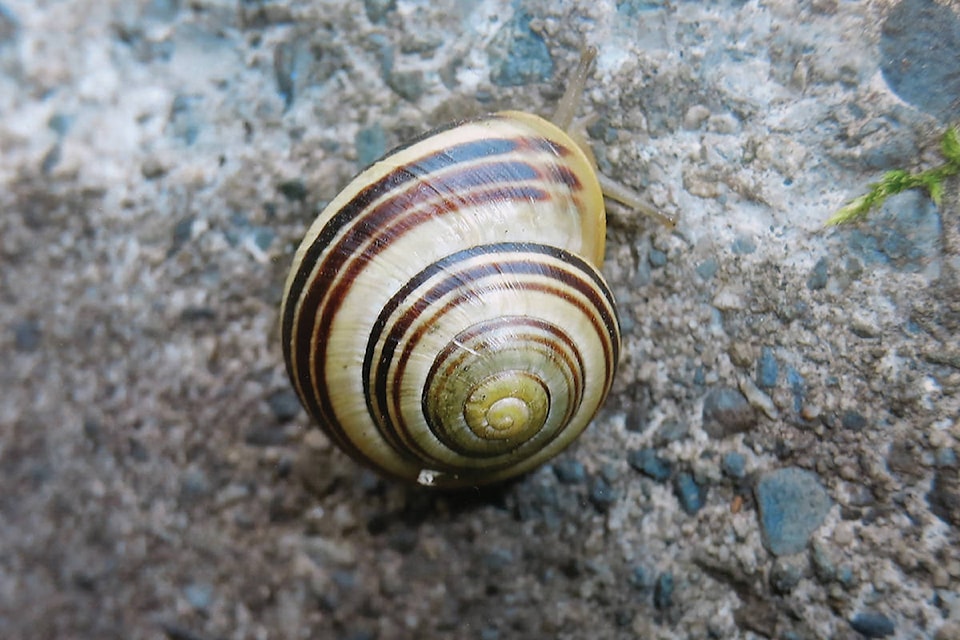Most of you have probably walked out on the seashore, stepping from rock to rock to avoid disturbing the little tide pools and the slippery seaweeds bunched around the rocks. One also tries to avoid stepping on the snails and periwinkles that cling to the rocks. But once in awhile one doesn’t get avoided and a member of the mollusk family gets crushed.
About the middle of May, large numbers of snails of one species appear in the Kootenay Lake drainage. Some years they have been so plentiful in a specific open area north of Creston’s Schikurski Park that it is nearly impossible to walk the trail through this particular field without crushing at least one with every step.
This snail is a colourful variety with several brown stripes or bands around the yellowish-white shell. On one side, at the beginning of the coils, is an apex or slight point. The opening of the shell faces right or clockwise (some snail shells coil counter-clockwise).
This snail appears to be the white-lipped snail (Capaea hortensis), also called white-lipped garden snail. It is native to Europe and was purposely or inadvertently introduced to North America. (Some snails were introduced to raise for use as escargot.) The name comes from the colour of the brim around the opening. The brown-lipped (Capaea nemoralis) has a brown stripe around the opening rim. The two species are very similar and vary considerably in the banding but for now I will settle for white-lipped snail until there is a better alternative. (Some misidentification does appear on the Internet.)
It is hard to believe that so many snails could simultaneously appear in one location but there are reasons for it, some obvious and some not. To start, this location may have been suitable and so the numbers increased from year to year as conditions remained stable. Snails require moisture and there seems to be an adequate supply of that. The brook underground seeps, and moisture from snow melt and the sheltered location keep the area humid even on warm days. (The town cemetery used to be northwest of this point but was moved out to Erickson when a dug grave filled up with water before interment could take place.)
The snails were not likely gathered there to mate, as most land snails are hermaphroditic, individual snails being both male and female.
Land snails have shells unlike many of their sea dwelling counterparts. Periwinkles have a shell.
Our terrestrial slugs, a close relative, like the black slugs and land snails, move about, sliding their “foot” along a little trail paved with slime. Sometimes one can tell they have been around the garden by the tracks they have left. If you track them down, you may catch up to them before they get to your lush lettuce leaves or leaves of other plants. Normally, in the wild, slugs and snails feed on leaves, fungi, decaying plant material and even on their dead next of kin. When I was a kid, to raise money, I would gather beer bottles and I often found snails in the empty bottles.
Some spiders have trap doors and so do some snails. When they don’t like the weather out there, such as when it gets too dry for them, they pull into their shell, and close the opening with a film of slime that hardens, helping them maintain their moisture. When they are active, they breath through a hole by the head, which has to be moist in order to adsorb oxygen. They breathe by opening and closing the hole to help push the air to the lungs.
They also have a mouth with a structure (redula) beside it that is covered with 2,000 or more microscope “teeth”, which tear at food to break it down into small particles. And the eyes! You might miss them unless you look at the tips of the first two stalks that appear when the snail pokes its head out of the shell. And, there is more!
Just because some creature or some plant has been introduced doesn’t mean it is not beautfiful, interesting or fascinating. By the way, weren’t most creatures and plants foreigners at some time?
Ed McMackin is a biologist by profession but a naturalist and hiker by nature. He can be reached at 250-866-5747.
